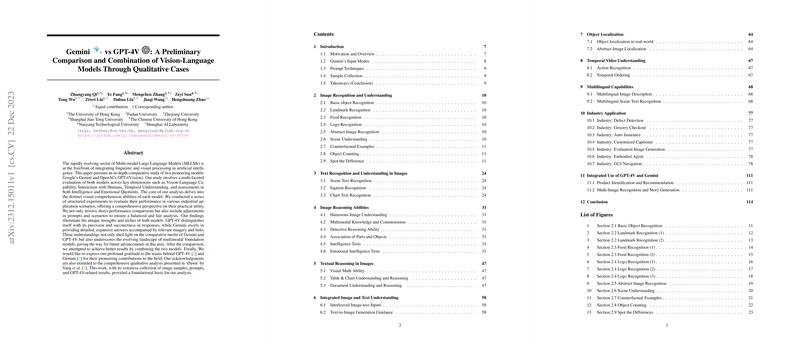Comparative Analysis of Vision-LLMs: Gemini and GPT-4V
This paper presents a comprehensive examination of two state-of-the-art vision-LLMs: Google's Gemini and OpenAI’s GPT-4V(ision). The paper evaluates these models across various dimensions, including their vision-language capabilities, human interaction, temporal understanding, and distinct visual comprehension skills. A series of structured experiments were conducted to assess their performance in multiple industrial application scenarios, offering insights into the models’ practical utility and integration potential.
Model Comparison and Performance
The evaluation reveals both strengths and limitations inherent in each model. GPT-4V excels in producing precise and succinct responses, presenting a high degree of accuracy in visual comprehension tasks. Conversely, Gemini is noted for generating detailed and expansive answers embellished with relevant images and links, enhancing its explanatory capabilities.
Image Recognition and Understanding
In basic image recognition scenarios involving object, landmark, food, and logo recognition, both models exhibit comparable performance. However, GPT-4V showcases a more robust ability when tasked with abstract image recognition. Scene understanding and counterfactual evaluation are tasks where both models adequately discern discrepancies, although Gemini's limitations in memory handling appear to affect its performance slightly.
Text Recognition and Reasoning
Both models demonstrate strong text extraction capabilities in multilingual and scene text recognition. However, when dealing with complex mathematical formulas and experimental table recognition, their proficiency declines. GPT-4V maintains an edge over Gemini in tasks requiring intricate reasoning, likely due to its advanced inferential algorithms.
Temporal Understanding and Multilingual Capabilities
GPT-4V outperforms Gemini in tasks involving the sequencing of events, benefiting from its coherent processing of temporal data. While both models display considerable abilities in multilingual tasks, recognizing and responding to varied language inputs effectively, GPT-4V still holds a slight advantage in scenario-based tasks.
Industrial Applications and Practical Implications
The analysis extends to speculating the role of these models in industry-specific applications, including defect detection, grocery checkout systems, and auto insurance evaluations. Gemini’s adeptness in providing image-rich feedback positions it as a potent tool in sectors demanding detailed visual inspections. However, GPT-4V’s precision solidifies its utility in contexts necessitating accurate data assimilation and succinct output, such as due diligence in financial and legal documentation analysis.
Conclusion and Future Directions
Both Gemini and GPT-4V stand as testaments to the advancements in vision-language integration within AI, each displaying unique attributes that cater to different user needs. The paper concludes by reflecting on the potential forthcoming entries, such as Gemini Ultra and GPT-4.5, which may further redefine the landscape of visual multimodal applications. Such developments promise to elevate model performance and broaden the scope of application in both academic and commercial sectors.
The paper advocates for a combined usage strategy, leveraging the preciseness of GPT-4V and the detailed expressiveness of Gemini, thus creating a more robust and versatile AI tool. As vision-LLMs continue to evolve, their integration into everyday applications will likely increase, demanding ongoing research to optimize their functionalities further for industry-specific challenges.
